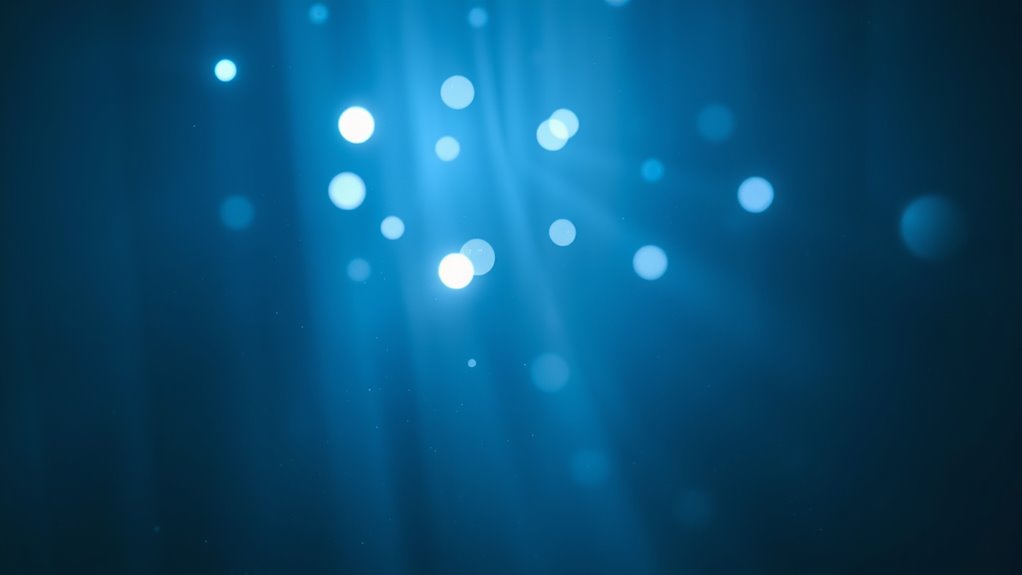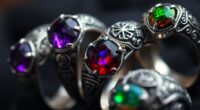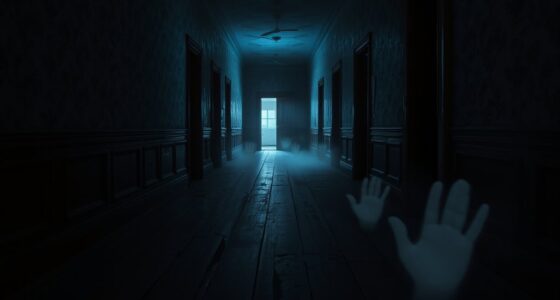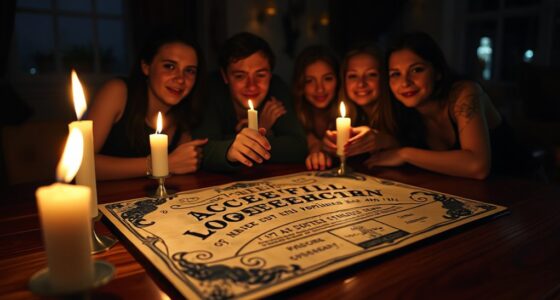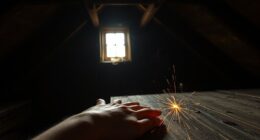Orbs in photos are usually caused by dust, pollen, moisture, or reflections illuminated by your camera’s flash, making them optical artifacts rather than ghostly evidence. Factors like lens flare, smudges, or particles in the air often create the appearance of glowing circles or spheres. These are natural phenomena, not paranormal, and can be distinguished by examining their shape, movement, and consistency. To uncover more about whether orbs are truly spirits or just optical illusions, keep exploring the details behind these mysterious images.
Key Takeaways
- Many orbs are caused by dust, pollen, or moisture reflecting light, making them photographic artifacts rather than paranormal entities.
- Camera settings, lens flare, and environmental factors significantly influence orb appearance, often creating illusions of ghostly evidence.
- Genuine orbs tend to be round, consistent, and show stable or slow movement, unlike irregular dust particles or reflections.
- Photographic artifacts like lens scratches or sensor noise can produce orb-like images mistaken for spiritual evidence.
- Analyzing shape, movement, and environmental context helps distinguish between dust, camera effects, and potential paranormal orbs.
What Are Photographic Orbs and How Do They Form?
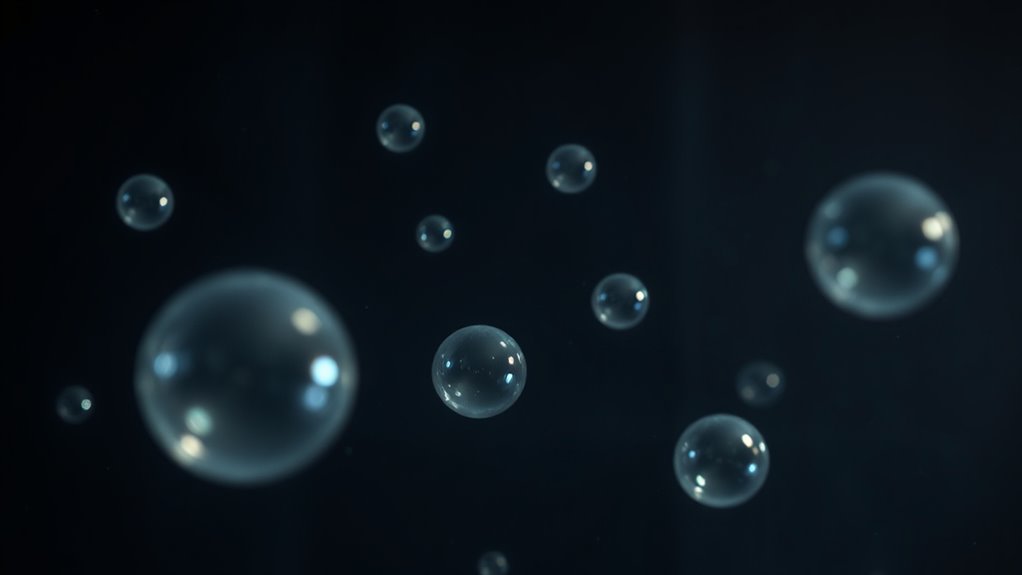
Photographic orbs are small, circular spots that often appear in photos, especially in low-light conditions. These orbs are considered by some to be evidence of paranormal phenomena, while others see them as photographic artifacts. They usually look like glowing circles or spheres and are most visible when the camera captures light reflecting off particles in the air. These reflections can include dust, pollen, or moisture, which are common causes of orb appearances. When you take a photo, camera flash or bright light can illuminate these tiny particles, creating the appearance of orbs. While some believe orbs indicate spirits or energy, many experts argue they are simply photographic artifacts resulting from environmental factors and camera technology. Additionally, understanding the causes of artifacts in photography can help clarify why these orbs appear in images. Recognizing the role of environmental factors such as dust or moisture can also aid in reducing unintended orb appearances in photographs.
Common Causes of Orb Appearances in Photos
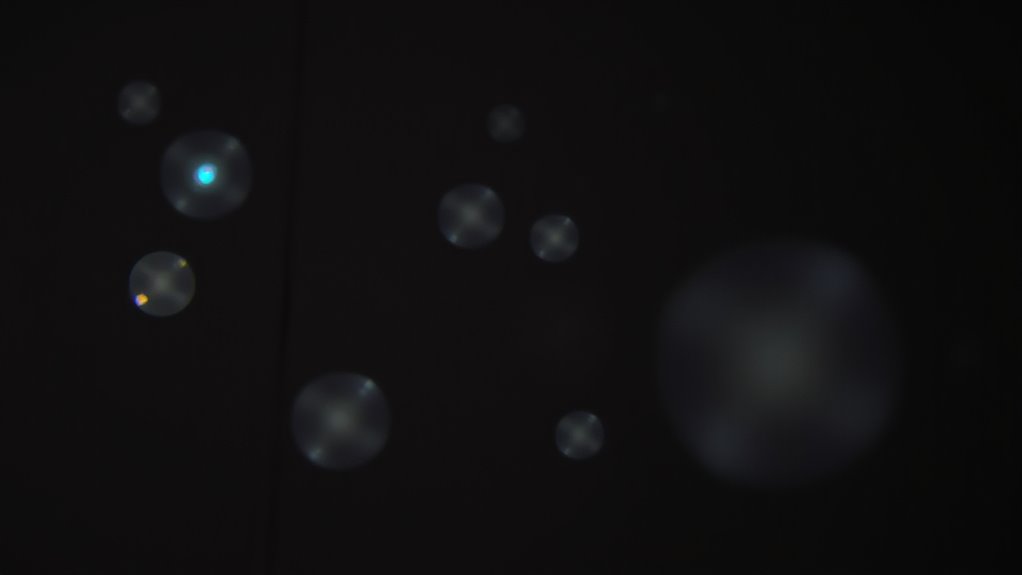
You often notice orbs in photos when dust or tiny debris float close to your camera lens. These particles reflect light, creating the bright circles you see. Additionally, flaws or smudges on your lens can produce similar orb-like appearances in your images. Some photographers also report that lens cleanliness can significantly affect orb visibility in their photos. Furthermore, projector contrast ratio influences how clearly such artifacts are visible in projected images.
Dust and Debris
Have you ever noticed small orbs appearing unexpectedly in your photos? These orbs are often caused by dust particles floating in the air or debris settling on your camera lens. When you take a picture, the camera’s flash or lighting can reflect off tiny dust or debris, creating bright spots that look like orbs. These reflections are especially common in low-light situations or when using a flash indoors. The particles can be so small that they’re invisible to the naked eye, but they become prominent in photographs. To reduce this effect, keep your camera lens clean and avoid shooting through dusty air. Remember, many of these orbs are just reflections from dust, not paranormal entities. Additionally, understanding dust and debris as common causes can help demystify these mysterious spots in your photos.
Camera Lens Flaws
Camera lens flaws are a common cause of orbs appearing in photos, often resulting from scratches, smudges, or dust on the lens surface. These imperfections can create lens distortion, which alters the way light enters the camera, producing bright spots or rings that look like orbs. Additionally, dust or smudges can reflect light in unpredictable ways, causing flare or glare that mimics paranormal phenomena. Sensor noise, especially in low-light conditions, can also contribute to orb-like artifacts; this graininess can produce small, bright spots that resemble orbs. Regularly cleaning your lens and avoiding scratches helps prevent these flaws. Understanding how lens distortion and sensor noise influence your images allows you to distinguish between actual orbs and camera artifacts. Moreover, remote work practices that promote a comfortable and organized workspace can reduce distractions and improve focus when reviewing photos or investigating anomalies. Implementing proper camera maintenance routines can significantly reduce the chances of misinterpreting artifacts as supernatural entities. Being aware of photo editing techniques that can introduce or enhance such effects further aids in accurate interpretation.
The Role of Camera Settings and Lens Flare
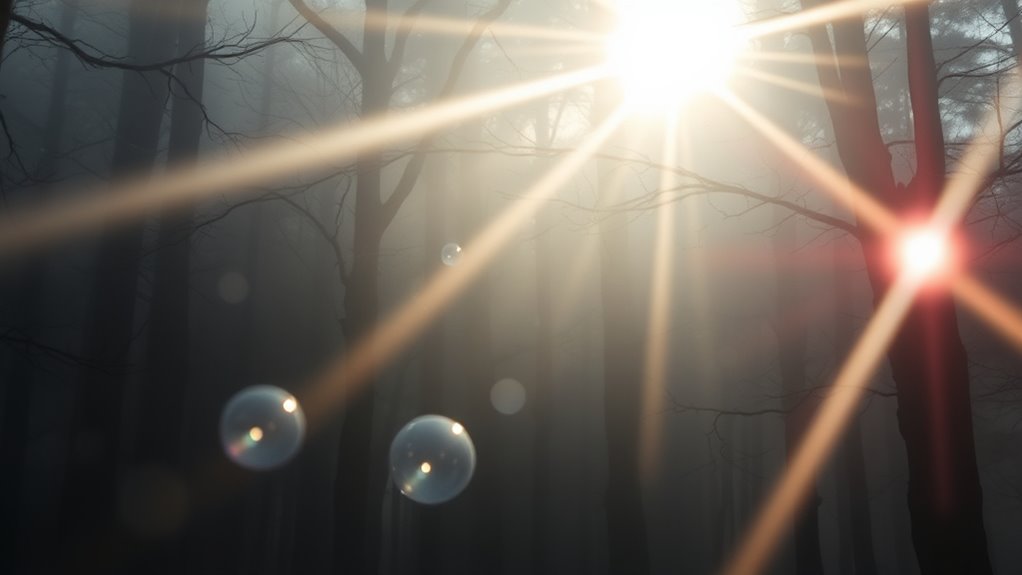
Understanding how camera settings influence the appearance of orbs in photos is crucial, as factors like exposure, aperture, and shutter speed can create or amplify these phenomena. For example, a wide aperture can produce aperture effects that make light sources appear larger or more diffuse, sometimes resembling orbs. Additionally, lens flare occurs when bright light hits your lens at certain angles, causing glare and reflections that can look like floating orbs. Adjusting your camera settings helps reduce these effects; using a smaller aperture minimizes aperture effects, while changing your angle or blocking direct light sources can lessen lens flare. Recognizing how these settings impact your images allows you to distinguish between genuine paranormal orbs and camera artifacts caused by lens flare or aperture effects. Being aware of photo artifacts and their causes can further aid in accurate interpretation of such images. For example, understanding how proper filtration and maintenance of your equipment can help prevent unwanted reflections or dust particles from appearing in photographs.
Debunking the Paranormal: Scientific Explanations

Many so-called paranormal orbs can actually be explained through scientific phenomena, which often go unnoticed without careful analysis. Dust, pollen, and moisture particles reflect light, creating orbs that appear in photographs. These are especially common in low-light conditions or when using a camera’s flash. During paranormal investigations, investigators sometimes interpret these orbs as spiritual symbolism or evidence of paranormal activity. However, scientific explanations suggest they are simply optical artifacts or natural particles close to the lens. Recognizing these mundane causes helps demystify orbs and prevents misattributing them to ghostly or spiritual phenomena. By understanding the science behind these images, you can approach orb sightings with skepticism and focus on more credible evidence, rather than jumping to paranormal conclusions based solely on visual artifacts.
Cultural and Historical Perspectives on Orbs
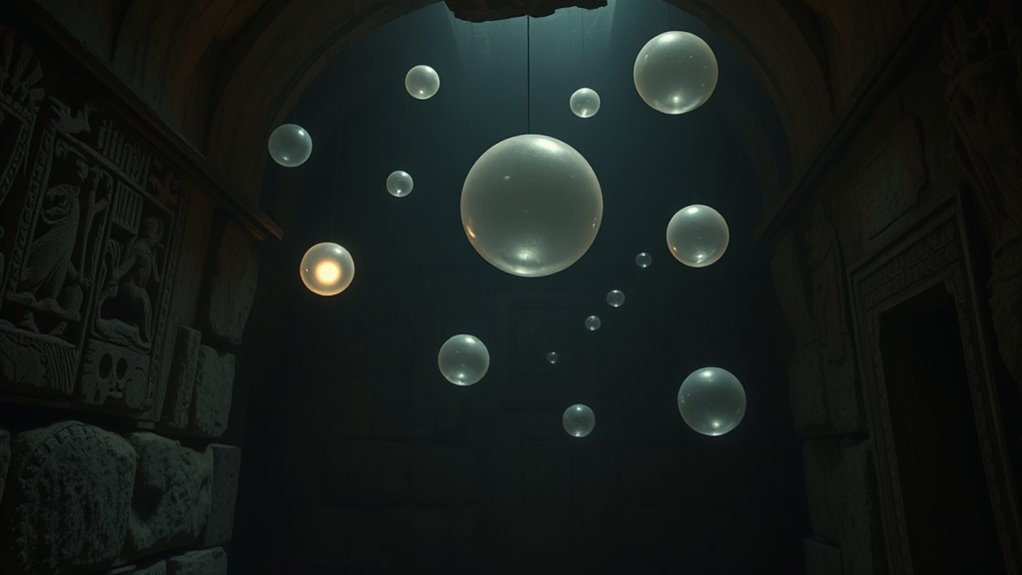
Throughout history, orbs have been perceived as powerful symbols across various cultures, often linked to spiritual energy, divine presence, or supernatural forces. Many societies interpret these luminous circles as signs of higher powers or messages from the afterlife. Cultural symbolism varies widely, with some viewing orbs as protectors or messengers, while others see them as manifestations of spirits. Historical interpretations reveal that ancient civilizations, like the Egyptians and Greeks, associated orbs with divine beings or sacred energy. These beliefs influenced art, rituals, and folklore. The study of symbolic representations in art and culture helps us understand how perceptions of orbs have evolved over time. In some cultures, orbs symbolize enlightenment or wisdom. Others see them as warnings or omens. Religious traditions often incorporate orbs in sacred imagery. The belief in orbs as spiritual phenomena persists today, and examining cultural symbolism allows us to appreciate diverse perspectives on their significance. Additionally, the perception of spiritual energy in various traditions continues to shape how we view photographic orbs culturally. These interpretations shape how we view photographic orbs culturally.
Techniques for Identifying Genuine Spirit Orbs
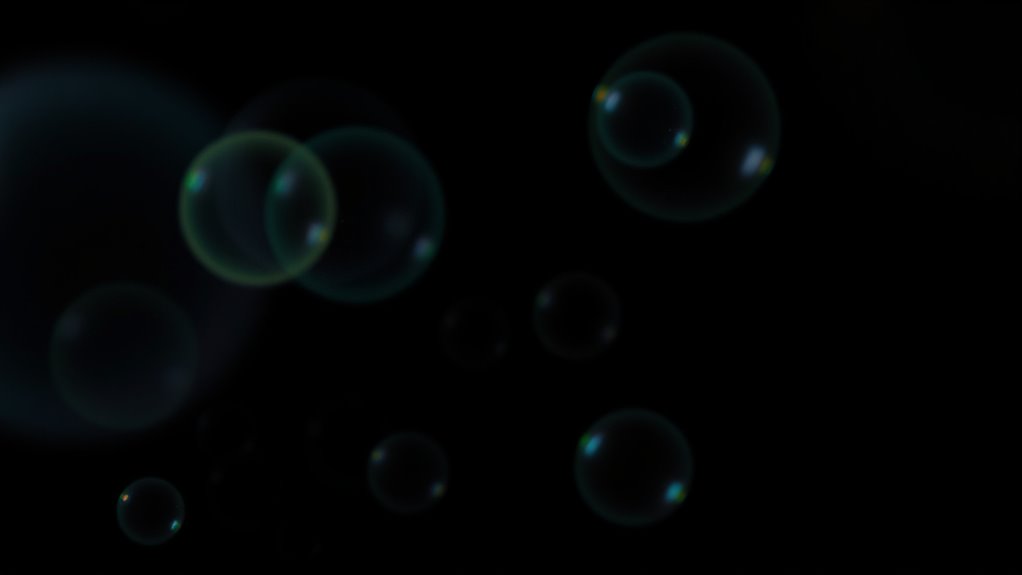
To identify genuine spirit orbs, start by examining the light patterns in your photos—look for consistent shapes and glow. Next, check for photographic artifacts like dust or lens flare that can create false orbs. By carefully analyzing these aspects, you can better determine which orbs are truly paranormal. Additionally, consider the retail hours of stores where you take photos, as crowded or busy environments may increase the chances of dust or other particles being present in your images. Being aware of photographic artifacts and their common causes can also help distinguish between real spirits and accidental anomalies. Understanding how different headphone types interact with your devices can also improve your recording setup and reduce equipment-related issues.
Analyzing Light Patterns
When analyzing light patterns in photos, you need to pay close attention to the shape, size, and movement of the orbs. Genuine orbs often display consistent, rounded shapes, while dust or bugs produce irregular forms. Look for signs of light reflection, which may cause the orb to glow unevenly or change brightness as you move the camera. Lens distortion can create elongated or oddly shaped orbs that aren’t authentic. Observe how the orbs behave across multiple shots—genuine spirits tend to remain stable, whereas dust particles shift unpredictably. Key indicators include:
- Uniform, perfectly circular shape
- Consistent size across images
- Stable position or slow movement
- No distortion caused by lens effects
- Brightness that responds to lighting changes
These patterns help you distinguish real spirit orbs from photographic artifacts.
Detecting Photographic Artifacts
Detecting photographic artifacts requires a keen eye for anomalies that don’t align with genuine spirit orbs. Digital noise often appears as random specks or graininess, especially in low-light conditions or high ISO settings, making it a common culprit behind false orbs. Photographic artifacts such as lens flare, reflections, or dust particles can also mimic orbs. To identify these, examine the photo closely for inconsistent shapes or positions that don’t move naturally with the scene. Genuine spirit orbs tend to be consistent in shape and size across multiple shots, whereas artifacts usually vary or appear only in specific conditions. By paying attention to digital noise patterns and analyzing the context of the image, you can better distinguish between authentic orbs and photographic artifacts.
Examples of Notable Orb Photographs and Their Analysis
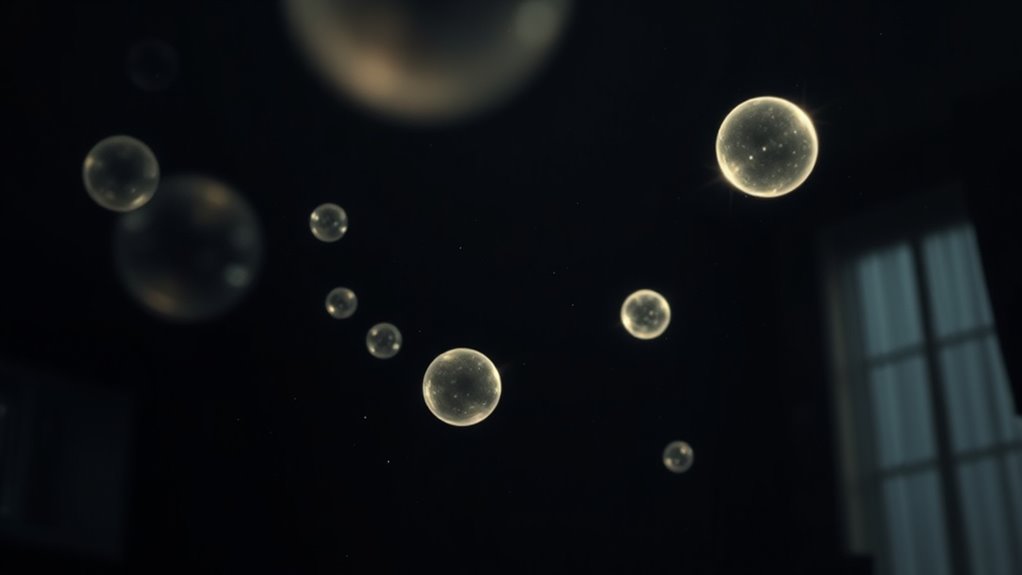
Have you ever wondered if those mysterious orbs caught on camera are genuine or just artifacts? Many notable orb photos have sparked debate, often linked to sensor artifacts or photographic illusions.
Many mysterious orbs in photos are likely just sensor artifacts or optical illusions, not paranormal entities.
- The 2011 “Ghostly Apparition” photo shows a bright orb near a window, likely caused by sensor artifacts from reflections.
- A viral image from a haunted house features a translucent sphere, which some interpret as a spirit, but experts cite photographic illusions.
- An outdoor shot with multiple orbs was analyzed and attributed to dust particles close to the lens, creating the illusion of floating orbs.
- A famous portrait’s glowing circle resulted from lens flare, a common sensor artifact.
- In each case, careful analysis suggests many orbs are just photographic illusions, not paranormal phenomena.
The Impact of Lighting and Environment on Orb Visibility
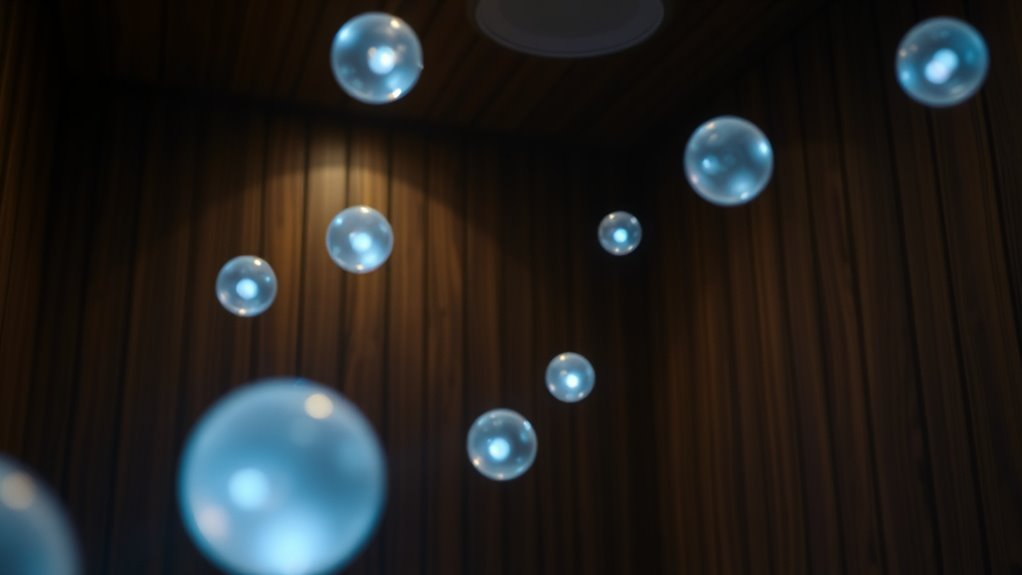
Lighting conditions and environmental factors play a crucial role in how orbs appear in photographs. Bright or uneven lighting can create reflections or flares that resemble orbs, while darkness may obscure or highlight them unexpectedly. Environmental factors like dust, mist, or moisture in the air can also influence orb visibility, making them more apparent in certain conditions. To illustrate, consider the following factors:
| Lighting Conditions | Environmental Factors | Result |
|---|---|---|
| Bright, direct light | Dust or pollen in air | Increased orb appearance |
| Dim lighting | Humidity or fog | Enhanced ghostly effect |
| Flash photography | Smoke or reflections | False positives |
| Overexposure | Particles on lens | Misleading orbs |
| Low light, shadows | Ambient moisture | Ambiguous visuals |
Understanding these influences helps you evaluate whether orbs are genuine or environmental artifacts.
How to Capture and Interpret Orbs in Your Own Photos
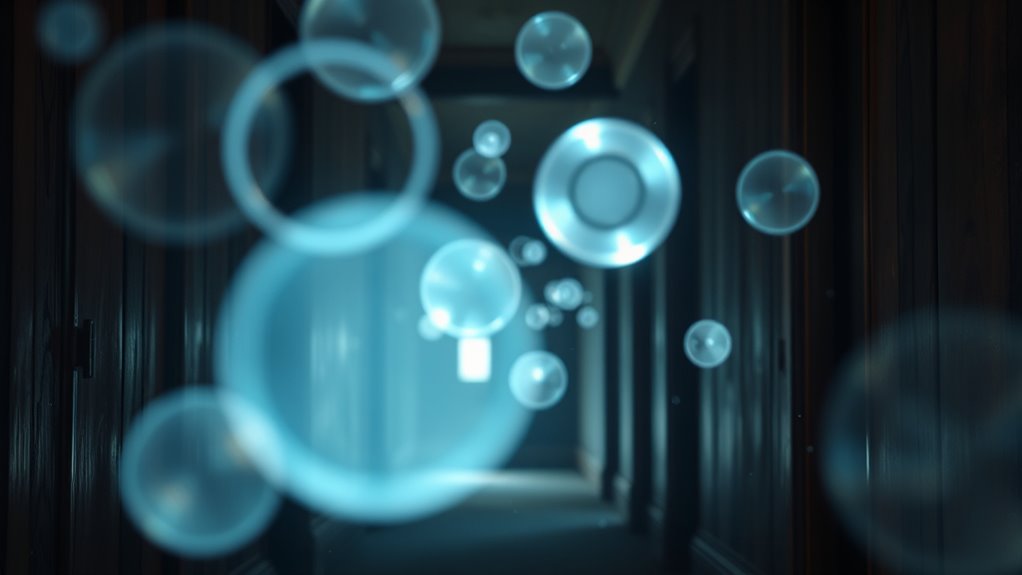
To effectively capture and interpret orbs in your photos, understanding how different settings and techniques influence their appearance is key. Adjust your camera to minimize digital noise by using lower ISO settings, especially in low light. Keep your lens clean to reduce lens reflections that can mimic orbs. Use a fast shutter speed to avoid motion blur and accidental reflections. Shooting with a flash can illuminate dust or moisture, creating orb-like images. Additionally, experiment with angles and distance to see how orbs change with perspective.
- Use a tripod for stability and sharper images
- Turn off any interior lights to reduce reflections
- Check for dust or moisture on your lens before shooting
- Avoid overly bright backgrounds that can cause flare
- Review photos for digital noise artifacts and lens reflections
Frequently Asked Questions
Can Orbs Be Intentionally Created for Paranormal Photography?
You can definitely intentionally create orbs for paranormal photography, often through digital manipulation or propaganda photography techniques. By using special effects or editing tools, you can craft orbs that mimic ghostly phenomena, making your images appear more mysterious. While some believe these orbs are evidence of spirits, many are simply tricks of light or digital enhancements, so understanding how to manipulate images responsibly is key to convincing paranormal photos.
Are There Specific Cameras Better Suited for Capturing Orbs?
When choosing a camera to capture orbs, you want to focus on camera quality and lens types. Higher-quality cameras with good low-light performance help you get clearer images, while macro or wide-angle lenses can better capture the details of orbs. You should also consider cameras with fast shutter speeds to reduce motion blur. Ultimately, a camera with versatile lens options and solid image quality will give you the best chance of capturing orbs effectively.
How Do Weather Conditions Influence Orb Appearances in Photos?
Sure, weather conditions totally love to spice up your photos with mysterious orbs. When it’s humid or rainy, moisture interference creates those perfect lighting effects that make orbs appear more dramatic—like a ghostly Instagram filter. Wind and drizzle can also stir dust or pollen, adding to the spectacle. So, if you want more orbs, just wait for weather that enhances lighting effects and moisture interference for extra spooky flair.
What Are the Psychological Effects of Seeing Orbs in Photographs?
Seeing orbs in photographs can trigger a range of psychological impacts and emotional responses. You might feel excitement, curiosity, or even fear, depending on your beliefs and experiences. These images can evoke feelings of connection or loss, influencing your mental state. Recognizing these reactions helps you understand how visual cues like orbs shape your perceptions and emotional well-being, often prompting introspection or a search for meaning.
Are Orbs Ever Confirmed as Genuine Paranormal Evidence?
You might wonder if orbs are genuinely paranormal evidence. While some claim they are spirits, experts say many are caused by photography techniques and camera settings, like dust or moisture close to the lens. To verify authenticity, you can analyze the photos for consistent patterns, use proper camera settings, and eliminate environmental factors. Ultimately, without scientific validation, orbs remain unconfirmed as real paranormal evidence.
Conclusion
Remember, not every glowing orb is a ghostly visitor—sometimes, it’s just dust or lens flare. Approach orb photos with a critical eye, knowing science often explains the mysterious. As the saying goes, “Seeing is believing, but sometimes, believing is seeing.” By understanding the causes behind orbs, you can better differentiate between genuine spirit evidence and everyday phenomena, enriching your curiosity without falling for illusions.
